The following article is based on Michael Thompson's presentation at the 2019 National No-Tillage Conference. To watch other presentations from the event, click here.
When Michael Thompson was 18 he envisioned himself joining his parents in their farming operation in northwestern Kansas and becoming a dedicated, 100% cash grain farmer. However, life and generations of conventional farming got in the way.
“I was all fired up that I was going to be a farmer. I was going to graduate high school, take some ag classes and come back to the farm,” he explains. “In 1997 I had the mindset that I hated cattle, saw no need for them, and I wanted to farm every acre of our land.”
Speaking to a gathering of producers at the recent National No-Tillage Conference in Indianapolis, Thompson recalled the rude awakening he got when his parents sat him down and explained that the farm wasn’t profitable and there was no way he could make a living there. They told him nicely, “Don’t come back to the farm.”
He didn’t listen, but he understood that if he was to make his living farming near his homestead in Almena, Kans., four counties east of Colorado on the Nebraska state line, he’d have to do things differently than the three previous generations of his family had done.
“There were a lot of reasons farming wasn’t working for us in 1997,” Thompson explains. “Probably the number one thing was we had such a low water infiltration rate — half an inch per hour, tops!
“What rain we would get would run down our hilly fields into the ditch and disappear. Our fertility bills were huge, yet we had very low fertility. Our soils were low in organic matter, some less than 1%, and we had no nutrient cycling whatsoever,” he recalls.
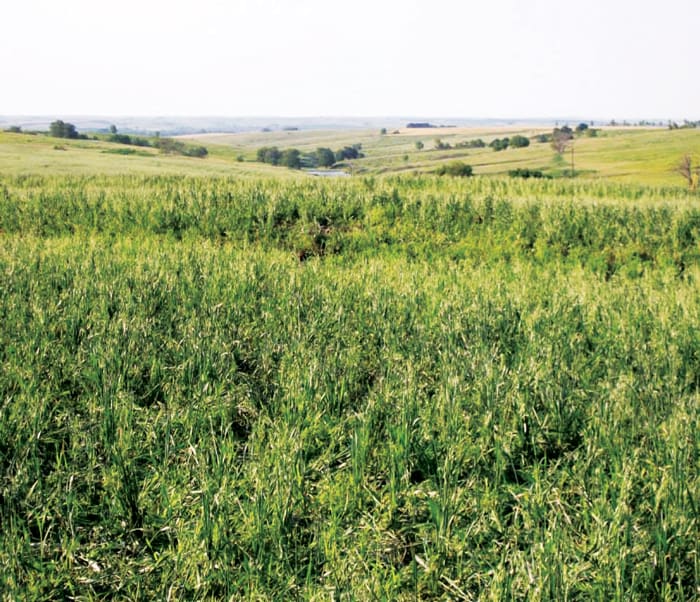
GENEROUS LEFTOVERS. Forage covers left behind Michael Thompson’s strip-grazing seem quite generous, but he says experience shows conservative grazing makes for better crops and soil conditions in the future.
“We had always farmed conventionally, so we had years of compaction. The soil was hard, so we had to work it to fluff it up, and then it would rain and we’d get stuck in the fields. We were either stuck or the ground was so dry we couldn’t plant,” he says.
Reluctantly, Thompson went to college instead of following his family’s footsteps, but he immediately bought 480 acres of his own near his family and worked his land nights and weekends, continually searching for ways to “fix the soil.”
That search for answers — and his stubbornness — paid off, because today Thompson’s operation includes about 2,000 acres of thriving corn, sorghum, winter wheat, soybeans, oats, barley and triticale, 1,000 acres of pasture land, and, ironically, for a guy who “hated cattle” as a high school senior, 180 cow-calf pairs of an Angus-based commercial cow herd.
His dryland corn yield averaged 170 bushels last year, compared with county averages of roughly 70 bushels, and he buys no herbicides, phosphorus (P) or potassium (K). He estimates his crops bring in about $216,000 more than what the county average would say is likely.
“Microbiology is free underground help. Without it you’re going to have to make it up with fungicides and herbicides, and you’re going to be buying extra fertility..."
“The cows, which I didn’t want as a younger man, add about an additional $48,000 a year to our business that I wouldn’t have if I’d realized my high school dream of being a 100% cash grain farmer,” Thompson explains. “Also, we’re saving about $13,000 a year in hay expenses, because we don’t have to harvest hay. It’s growing or standing in our fields.”
In addition, Thompson says wind and water erosion have been significantly reduced, and soil organic matter content has more than doubled in his fields.
A New Way of Thinking
“When I started farming on my own I spent a lot of time reading books and on-line articles, going to conferences, studying alternatives, and trying to learn everything I could about what I could do to successfully farm in our harsh climate with high summer temperatures and infrequent rains, severe winter conditions and light soils that blow or wash easily,” he explains.
Thompson says as a “practicing student” he realized he would have to mimic the native prairie culture which built the soil he was trying to farm, and that meant quitting the plow — a decision he made in 2000.

TALL FORAGE. Summer cover crops on Michael Thompson’s place provide quality grazing and ample shade for soil protection. This kind of standing forage also comes in handy as stockpiled “hay” when cattle shift off of corn stalks in the fall.
“We knew we had to no-till to combat erosion and that was working, but we quickly developed weed problems. We responded by getting into multiple-species, planting cover crops to help get rid of the weeds, but even that didn’t solve the problem.”
Finally, out of necessity, Thompson said it dawned on him that his family had cattle and cattle would eat weeds along with the cover crop mixes. “So, we started turning the animals out!”
Once animals were introduced into the farming operation, Thompson said he saw significant changes in weed pressure, and crop performance on acres grazed while they were in covers. Also, despite decades of compaction from conventional tillage, Thompson says he’s seeing much improved water infiltration rates along with apparent nutrient scavenging from his cover crops and increased soil biological activity.
Developing Diversity
“I try to make the farm resemble the native prairie, which doesn’t just have one set of roots,” he says. “Native prairie has a diverse plant population with varying root system depths. Some are shallow, but some go down, 6, 8, 10 feet in the ground. Some even penetrate the soil 20 feet, and before we started farming the Great Plains, that ensured water infiltration in our prairie soils.”
“We’re doing this to make a living and be economically viable, but we’re also being stewards of our soil…”
Today, as Thompson and his father and brother rotate row crops with winter wheat, they try to plug in the proper warm- or cool-season cover-crop mixture to meet conditions for the coming season and provide extra forage for their cow herd.
“I recommend including something you don’t have in your current crop rotation when selecting cover crops,” Thompson says. “If you’re mainly a corn/bean producer, you need a cool-season broadleaf and cool-season grasses.
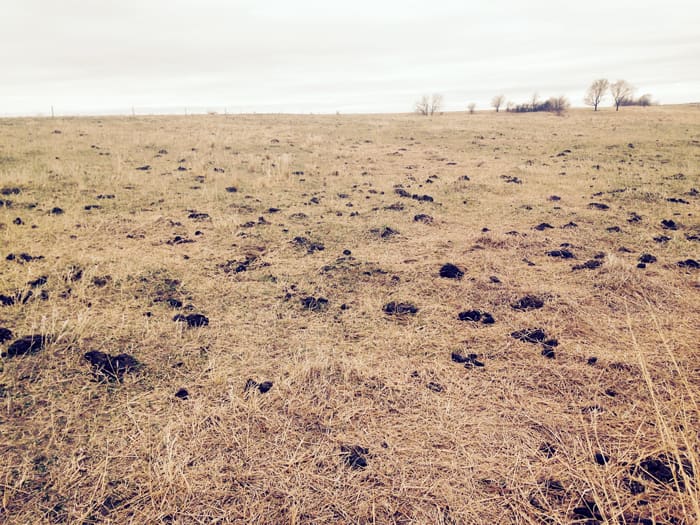
EVEN SPREAD. Open grazing takes years to distribute manure evenly on a one-yard basis, but Michael Thompson says by bunching cattle in small paddocks and moving hourly, or daily, the same effect can be had in a single year.
“If you’re in a really wet area, I’d suggest maybe even some perennials to go down deeper into the soil,” he says. “In our area, with our dry conditions, I’m also a firm believer that you need a deeper tap-rooted species to break up the hard pan from previous tillage and to penetrate deeply to scavenge nutrients and moisture.”
Thompson’s spring cool-season cover mixtures include spring oats, barley, spring forage peas, sunflower, crimson clover, turnips, rapeseed and, depending upon the expected growing season conditions, radishes. Fall cool-season mixtures are made up of spring oats, triticale, rye, rapeseed and hairy vetch.
“For warm-season covers we use German millet, proso millet, forage sorghums, sorghum Sudan, sunflowers, cowpeas, Mung beans, and Sunn hemp,” he explains.
Thompson says it’s essential to have many species at work in fields, because the more diversity you have growing the more likely you’ll have something that will thrive, or survive, given severe weather events.
“You might get a late freeze. You might get an early freeze. You might get a drought. You have to plan for that by creating a lot of diversity in your mixes, because chances are there’s something that’s going to take out some of those species,” he warns.
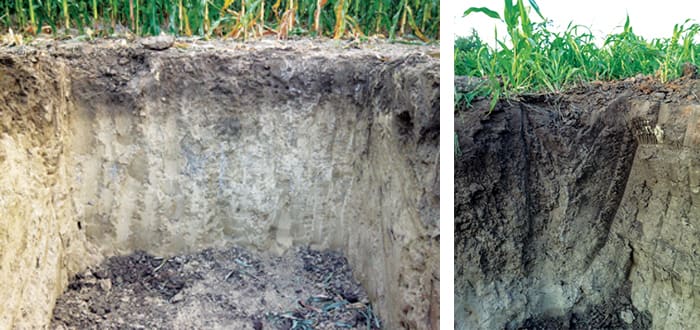
FOUR YEARS’ WORTH. The field on the left has been in no-till, with no cover crops or grazing and shows about 12 inches of carbon in the top soil. In a nearby adjacent field of the same soil type, Michael Thompson raised two field crops and did two grazings each year over four years. Carbon building is evident there down to 38 inches.
Thompson urges producers to study and take advantage of the synergy between plants, such as water and nutrient sharing. He cites research showing various plants can supply neighboring plants with nutrients and water through intricate and extensive networks of mycorrhizal fungi that thrive in undisturbed soil and populate the plant roots themselves as well as the adjacent soil in the root zone.
“Another consideration for mixtures is an accelerated rotation,” he explains. “If you’re planting a monoculture cover crop, it will take you eight years to accomplish the same biological effects that planting an 8-way multispecies mix would provide.
“If you have eight different plants growing in one year, however, you just went through eight years in a single year, so basically you’re speeding up biological time by providing more diversity in root depth, types of exudates and distributions of soil microbes.”
Animal Advantages
Thompson says there are three benefits animals bring to his farm, and the number one improvement he sees from grazing forage covers is residue management.
“Many times in no-till, crop residue just stands there until it rots off and falls to the ground late in the season,” he explains. “With cattle, if you manage them with electric fencing, you can get that residue on the ground quickly and in contact with the soil and its microbes. That quickly starts recycling those nutrients that your cover crops recovered for you.”
Because of the more rapid breakdown of crop residue through grazing, Thompson says he rarely uses residue managers on his 16-row International 1230 stack-fold planter or the air-drill he uses to establish cover crops.
“Occasionally we’ll use shark-tooth wheels on heavier covers, but usually we run the standard stock row units on the planter because our residue is being consumed so quickly,” he explains.
Number two, he says, is that soil biology increases immediately from the outset of introducing animals to the field.
“You’ve got a ruminant animal that is full of cellulose digesters — all the biology that is inside the gut of the animal — and a lot of that comes out in manure,” he explains. “You jump start soil biology with cattle through the manure and urine.”
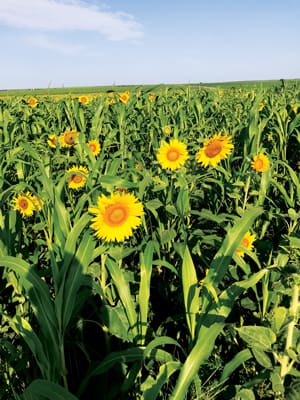
SUNNY COVER. Sunflowers provide good forage in summer cover crops for Michael Thompson, as well as do some heavy lifting to break compaction with their deep tap roots.
Third, Thompson says, grazing plants stresses them, which causes them to increase their output of nutrient exudates through the root system.
Research shows that plants deposit up to 50% of the sugars they produce through photosynthesis back into the soil near the roots — which feeds various soil microbes such as bacteria, fungi and arthropods. Thompson says grazing causes additional production of these root-zone sugars which further benefits the soil population.
“Grazing causes this reaction, and when a cow grazes, it actually wraps its tongue around a plant, gives it a yank and removes the top growth — which is stressful to the plant. It begins leaking more sugars into the ground, which feeds the local microbial population, which in turn helps feed the plant, allowing it to recover,” he explains. “Grazing shocks the plant and makes it work harder, but that also boosts the work of our soil microbes.”
For the most part, Thompson strip-grazes his cow-calf pairs as a herd, controlling their numbers per acre according to forage and weather conditions with portable electric fencing. Throughout the grazing cycle, however, he says he’s careful to graze conservatively and leave more forage standing than many would think wise.
“We once learned the hard way that overgrazing our covers cost us in wheat yields the following season,” he explains. “Where we didn’t get the cattle moved soon enough, we had a 10 bushel wheat crop. Right next to that disaster, where we left adequate cover behind the cattle, our wheat made 45 bushels.
“We match conditions and the amount of forage with the time of year for an ‘elastic’ paddock size,” Thompson explains. “And, we’ve seen some very rewarding things when we bunch them up and leave them on a small paddock for only a few hours or part of a day. We especially see yield benefits — 5-7 bushels per acre — in intensively-managed grazed covers that return to corn the following season.”
Much of that effect comes from even manure deposition.
“I read a Missouri University study which indicated it would take 27 years to get one manure pile per square yard given the size herd in the study,” Thompson explains. “But you can make that happen in a single year if you control paddock size and just move your cattle daily.”
He says besides the fertility boost of the nitrogen in cattle manure, the even spread of microbes in manure enhances the soil’s natural microbial population.
“Microbiology is free underground help,” Thompson explained. “Without it you’re going to have to make it up with fungicides and herbicides, and you’re going to be buying extra fertility. The microbes can help you bankroll better management.”
Biological Advantages
Since fully adopting cover crops as a management tool in 2009, when up to 500 acres or more of the Thompson farm might be found in cover crops at any time of the year, Thompson says he immediately saw significant reductions in soil erosion, better water infiltration and reduced evaporative losses from his fields because of residue and cover crop shading.
Also, he has been cooperating in various agronomic trials which have allowed him to cut back on crop inputs because of the increased biological activity no-till and animal agriculture are adding to his fields.
“Using the Haney Test, in addition to our university-based traditional soil sample analysis, we’ve found we no longer need to purchase P and K to maintain or grow our yields,” he explains.
The Haney Test, which measures CO2 produced by soil microbes, provides an indicator of soil biology and has been found to correlate with nitrogen (N) available to the crop from sources other than those detected by popular university and commercial lab soil assays that depend upon an acid-based laboratory technique.
“The Haney Test has helped us look above and beyond what we’re applying for fertility,” Thompson explains. “It tells us when we may be able to lay off a side dressing, or a last spoon-feeding of the season, and it’s worked pretty well for us.
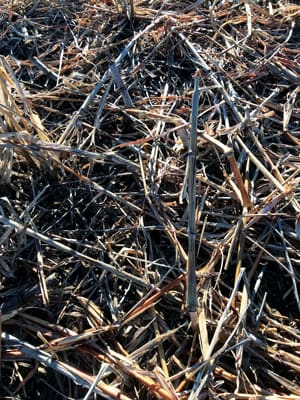
SOIL CONTACT. Grazing cover crops allows trampling which brings crop and cover crop residue in contact with the soil quickly, leading to immediate start of nutrient cycling. Michael Thompson says because of rapid residue decomposition, he has very little trouble with field trash in his no-till planting.
“Through this kind of science we’ve been saving money through nutrient management — we’ve stopped front-loading a season’s worth of N on our row crops, and that has saved us money and helped our yields,” he says. “Every year we’re reaching our yield goals, and nearly every year over the past 6-7 years we’ve improved our yields with this systems approach and the improved soil biology in our fields.”
Thompson says improvements in soil organic matter goes hand in hand with improving the biology of farm fields.
“Organic matter is basically the house for your microbes, but if you don’t have that water-extractable carbon from the exudates of plants, the microbes start tearing down their house. They will be eating the walls — eating your organic matter,” he explains. “That’s why it’s so important to have something growing at all times, producing sugars for the microbes.
“Microbes are like us, they like sugars, and to them, organic matter is like cardboard, but they’ll eat cardboard if they don’t have sugars.”
Thompson says the Haney Test seems to work best when there is adequate moisture, and he recommends using it by sampling at the same time each year when soil conditions and temperatures are similar.
Consequential Decisions
Thompson showed his Indianapolis audience a slide of an 8-acre plot of corn that exceeded 200 bushels last year, and compared that with his county’s average of 70 bushels.
“I’m not saying this to brag or draw attention to myself,” he explains. “I’m saying this because we’re changing our soils for the better.
“When you get the nutrient cycling happening with the animals you can do things that I never would have thought were possible. My goal when I started this was to have 100 bushel corn and I thought before I died I’d hit 2% organic matter in my fields. Today, our fields measure 2.5-3% soil organic matter.”
“We’re doing this to make a living and be economically viable, but we’re also being stewards of our soil,” he says. “I have a son who’s nearly five. I’m investing in my future so I don’t have to tell him at 18, “There’s no hope for you, go out and get a job somewhere else. I want him to be able, if he sees fit, to be a farmer and come back here and farm.
“We’re learning we don’t have to farm bigger. We just have to farm better on what we’re doing now.”

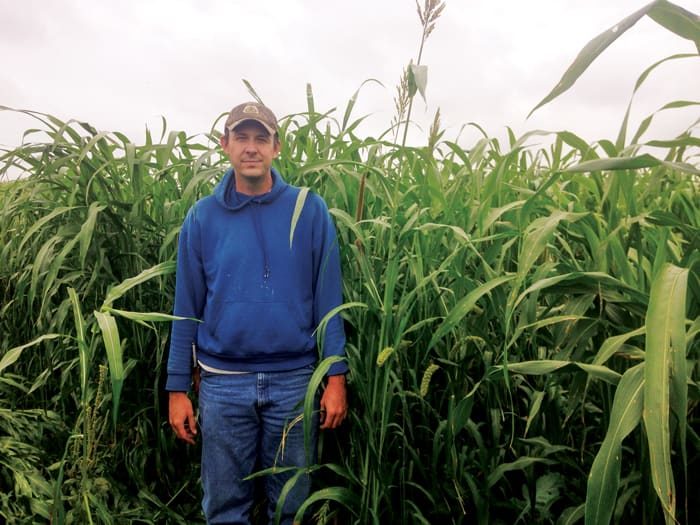






Post a comment
Report Abusive Comment